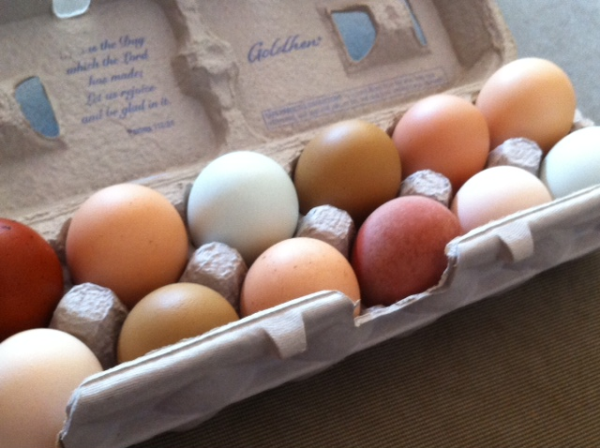A Guide to Egg Carton Labels, Separating Fact from Fiction
Food companies have hired marketing experts to make their Brand the most desirable, while putting catchy labels on inferior products they are misleading consumers into a false sense of quality. Since eggs are one of the most accessible, easiest and cheapest sources of protein out there, it’s worth a little extra effort and well worth a few pennies to get the best available for your budget. Let’s separate fact from fiction, wade through the familiar sounding terms to understand the true meaning: A Guide to EGG CARTON LABELS.
There are basically 11 terms used to describe eggs and they are often found in combination to make it even more confusing.
- Free Range: Sounding like the chickens have complete access to the entire farm, this terms is used to make big in-door production farms seem outright wild. These operations typically house the flock in buildings as large as 2 football fields with no windows or sunlight, with a 10′ x 10′ pen attached to one end. Because of the crowded conditions most chickens choose to stay indoors and never once step foot in the pen.
- Cage Free: Sounding like chickens on parole this term is referring to the industrial factory farm practices above, just without the option of the attached pen, which is mostly useless anyway.
- All Natural: Seeing that this term is not regulated and can mean just about anything that occurs on the planet it does not hold much weight. The chickens are typically raised in small cages of 4-12 hens and unable to even stand. They can be fed Genetically Modified grains, sawdust and even the ground up chickens that didn’t make it. My advice, stay clear.
- Anti-Biotic Free: The term is of no value in egg production as Anti-Biotics are rarely used for this type of farming. Anti-Biotics are used in raising chickens for meat production and egg layers aren’t bred for meat production. Again a meaningless term.
- Hormone Free: Since it is illegal to use hormones in the egg production industry… well you get the point.
- Farm Fresh: Even more obscure than All Natural. Provides no clarification and as in most of the terms shown above is just a marketing ploy.
- Vegetarian Fed: Somewhat helpful as this tells you there was no animal byproduct in the diet including bone meal or other chickens. Most likely these birds are eating a Corn based diet ( possibly GMO )fortified with amino acids. Keep in mind that this excludes worms and insects which are part of the regular food chain for healthy birds.
- Certified Humane: A term with various definitions applied by third party verifications. it usually entails a chicken per square foot minimum requirement, but often allows cages and enclosures with no sunlight or access to the outdoors. Check with the certifying agency for exact details.
- Omega-3: This term refers to hens that have a diet with added fax seeds to the standard GMO corn ration. There are other methods of adding Omega-3 to a hen’s diet and a little detective work on the companies website will give you a better understanding of their diets.
- Pastured: This is by far the only way to be sure that your egg producers ( the hens themselves ) are having anything near a natural lifecycle. They spend most of the time outdoors, picking at whatever pleases them for a balanced diet. Insects , worms, grasses, clover, bees and hopefully ( you may not like this, but ) moist young maggots in manure droppings. They can also be supplemented with GMO corn, especially in the winter months. To be sure it’s non-GMO, look for additional terms on the carton.
- Organic: Organic egg production is the production of eggs through organic means. In this process, the poultry are fed organic feed. According to the United States Department of Agriculture, organic means that the laying hens must have access to the outdoors and cannot be raised in cages.
Eggs are an exceptionally nutritious food. It’s not surprising, considering they contain everything necessary to build a chick! But all eggs are not created equal. Anyone who has seen the tall, orange yolk, viscous white, and tough shell of a true pastured egg knows they’re profoundly different. So has anyone who’s tasted one. This has been vigorously denied by the American Egg Board and the Egg Nutrition Council, primarily representing conventional egg farmers, which assert that eggs from giant smelly barns are nutritionally equal to their pastured counterparts.
The magazine Mother Earth News decided to test that claim. They sent for pastured eggs from 14 farms around the U.S., tested them for a number of nutrients, and compared them to the figures listed in the USDA Nutrient Database for conventional eggs. Here are the results per 100 grams for conventional eggs, the average of all the pastured eggs, and organically raised eggs
Vitamin A:
- Conventional: 487 IU
- Pastured avg: 792 IU
- Organic raised: 1013 IU
Vitamin D:
- Conventional: 34 IU
- Pastured avg: 136 – 204 IU
- Organic raised: 220 – 421 IU
Vitamin E:
- Conventional: 0.97 mg
- Pastured avg: 3.73 mg
- Organic raised 4.02 mg
Beta-carotene:
- Conventional: 10 mcg
- Pastured avg: 79 mcg
- Organic raised: 100 mcg
Omega-3 fatty acids:
- Conventional: 0.22 g
- Pastured avg: 0.66 g
- Organic raised: 0.74 g




No Comments